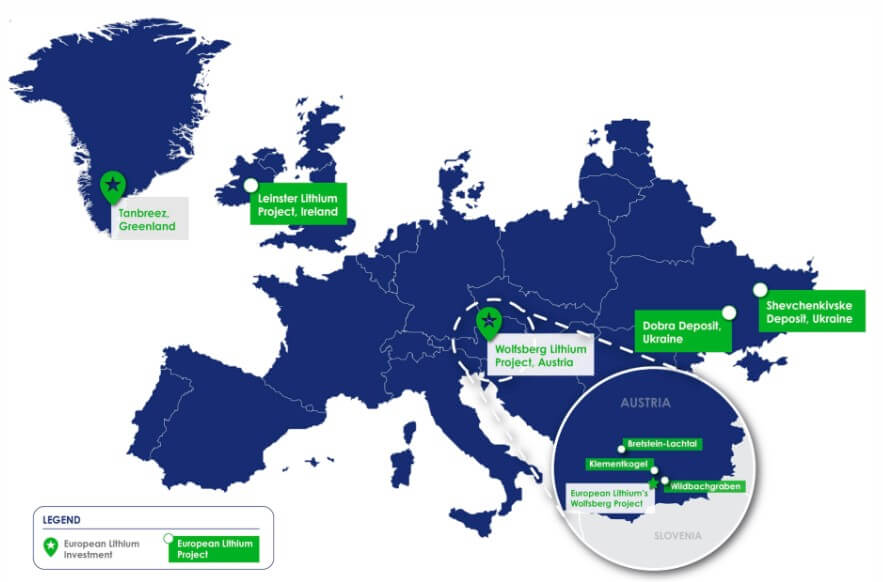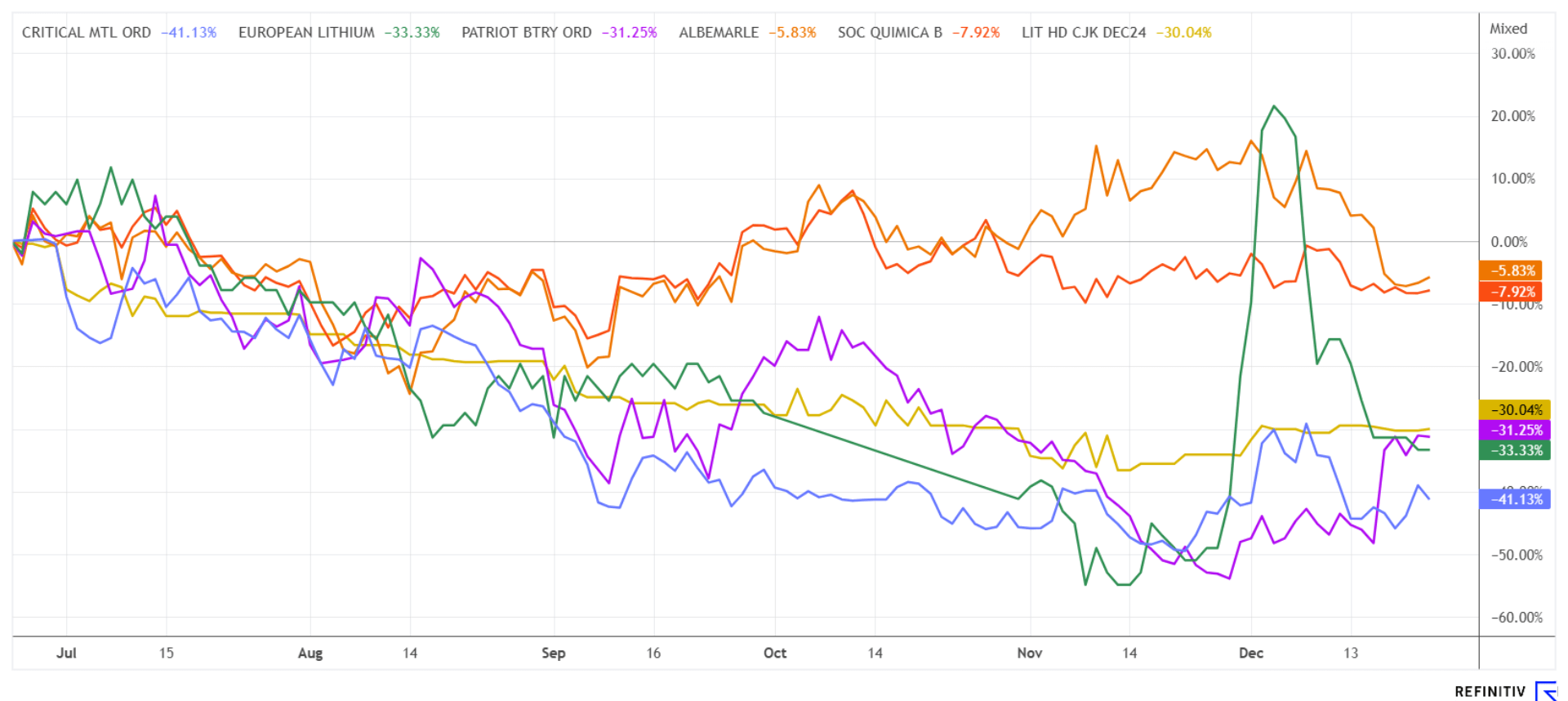Back to 2021 – Is a new lithium hype on the cards?
Republican Donald Trump aims to revive traditional industries with his "America First" policy while simultaneously embracing modern crypto technologies, as evidenced by his contemplation of Bitcoin as a strategic currency reserve. A high-tech future fuels the demand for strategic metals, especially in the field of batteries and storage technologies. The suppliers of these sought-after metals are therefore confronted with constantly growing demand, which can only be compensated for in the next 10 years by the consistent expansion of mining sites. According to estimates, the existing supply of critical raw materials such as lithium, nickel, cobalt and copper is insufficient to meet the goals of the energy transition. A study by the International Energy Agency (IEA) shows that demand for lithium could increase tenfold by 2050. This white metal is a key raw material for producing lithium-ion batteries, which are used in electric vehicles and other electrical devices. China is rapidly expanding an integrated lithium-ion battery supply chain, taking advantage of the recent price momentum by acquiring and investing in spodumene producers. As Europe and North America, particularly the United States, are also accelerating the transition to electric vehicles (EVs), demand for lithium is increasing significantly.
“Demand for lithium could increase to 10 times today's level by 2050!”
In addition to the continued demand for combustion vehicles, major carmakers such as General Motors and Ford are steadily expanding their production capacity for EVs. However, the e-visionary Tesla still leads the US market with a share of over 30%. 2023 to 2024 are to be seen as transition years because not all groups of buyers have turned to e-mobility yet, especially after the abolition of the environmental bonuses in Europe. Some indicators suggest that a new electric hype is on the horizon, with lithium prices now lower. Lithium demand remains high, even if sales figures are slowing somewhat. Not to be forgotten, lithium remains indispensable not only for EVs but also for energy storage systems used in renewable energy sources such as solar and wind power. These batteries help to store electricity from these sources, which helps to stabilize the power grid and reduce dependence on fossil fuels. Major efforts are being made to build more domestic production capacity and to promote the mining of lithium in Europe and North America in the future. This is part of the strategy to ensure secure supply chains for critical raw materials.
European Lithium Ltd. - Rich in global projects
European Lithium (WKN: A2AR9A | ISIN: AU000000EUR7 | Ticker symbol: PF8 | ASX: EUR) is a publicly listed exploration and development company with international lithium and rare earth projects, primarily in Europe. The long-term goal of the Australian company is to be the first supplier of battery-grade lithium in a fully integrated European battery supply chain. In 2023, the EU decided that by 2030, at least 10% of the demand for strategic raw materials should be covered by domestic production and that 40% of the raw materials should also be processed in the EU. The focus is on research and innovation to make the mining and processing of these raw materials more sustainable. The EU also seeks strategic autonomy to achieve its climate targets and make the domestic economy more resilient.

Austria: BMW to source lithium from Wolfsberg in the future
European Lithium's flagship deposit is located in Wolfsberg (WLP), approximately 270 km southwest of Vienna in Carinthia, Austria. This hard rock deposit has a history of exploration and features a JORC-compliant resource with significant exploration potential. The properties cover approximately 114 km2 and were acquired in 2023/24, with historically measured grades of up to 3.98% Li2O. The deposit is strategically located in the middle of the growing European battery cluster to supply European lithium consumers and the local electric vehicle industry. The recently completed positive pre-feasibility study (PFS) confirms the feasibility of the project and the planned sale of lithium hydroxide.
The WLP project has already been spun out into the separately listed company Critical Metals Corp. (NASDAQ: CRML) so that the financing of further steps for development and production does not result in additional dilution for European Lithium. Almost EUR 1 billion is needed for the WLP project, with around EUR 140 million already committed by BMW and Global Emerging Markets (GEM). EUR 286 million are to be raised through capital increases at CRML, with a further EUR 540 million coming from banks or financing companies. According to the Refinitiv Eikon platform, European Lithium currently owns a 73.22% stake in CRML, which in turn has a market capitalization of USD 617 million. The Austrian Wolfsberg lithium project is the most important CRML property to date, and it has already signed an offtake agreement with Munich-based Bayerische Motoren Werke (BMW). This partnership not only underscores the quality of the project but also ensures long-term revenues and market presence.
Ukraine and Ireland: Lithium deposits on site
The European properties of the Australian company make the entire structure of European Lithium highly appealing, especially in light of the upcoming second presidency of Donald Trump. With peace in Ukraine, the Dobra and Shevchenkivske projects are set to take centre stage. The potential of the Dobra deposits is estimated at 80 to 105 million tons with 1.1 to 1.4% lithium oxide (Li2O), and in Shevchenkivske, the Company expects 11 to 14 million tons with 1.2 to 1.3% Li2O. European Lithium is gaining momentum with the official announcement that Australia will reopen its embassy in Kyiv at the beginning of 2025. It can also be assumed that once peace has been established, Western investors will quickly emerge, seeking to secure access to Ukraine's raw material deposits with investment commitments. In the long term, Ukraine could thus become a key zone for Western future-oriented industries. Currently, the properties near the war zone are valued at "zero", but they could quickly become a valuable asset for European Lithium shareholders after a ceasefire.
In November 2024, European Lithium acquired the Leinster Lithium Project in Ireland through the transfer of Critical Metals shares worth USD 10 million. Historic drilling at the Irish lithium project, with a total size of 761 km2, has yielded impressive results, including samples with lithium grades of up to 3.75%. This is a high lithium content for Europe and makes the project another strategic asset for the Company. The Chinese lithium giant Ganfeng is currently re-exploring the area and plans to assess its economic viability. This sets the stage for a potential project acquisition by a strong partner already in play.
Lithium processing in Saudi Arabia
For cost-effective processing, European Lithium is looking for alternatives abroad, where energy costs are only a fraction of those in Austria. The solution lies in an interesting joint venture between CRML and the Arab Obeikan Investment Group to build a lithium converter in Saudi Arabia. According to the CIC Energigune Version 7 (2022) study, European countries plan to build up an annual production capacity of 550 GWh in Li-ion batteries by 2023, for which the necessary lithium concentrate is needed. Since energy in Europe is currently in short supply and too expensive, the project in Saudi Arabia comes at exactly the right time, because processing costs will be up to 30% lower. Local subsidies for international industrial settlement, lower energy costs, and tax breaks make this option particularly attractive.
Trump card Donald Trump - Greenland becomes an evaluation jackpot
Another trump card for European Lithium is its rare earth engagement in Greenland. The global market for rare earth oxides amounted to about 209,000 tons in 2023 and is expected to grow at a compound annual growth rate (CAGR) of 6.1% through 2035, according to a study by Adamas Intelligence Inc. (Adamas).
The fully approved "Tanbreez" project, located in southern Greenland, is the world's largest project for rare earth elements in terms of in-situ tonnage, which is essential for high-tech products and green technologies. Critical Metals holds a 42% interest in the project and European Lithium 7.5%. Critical Metals can increase its share to 90% through further drilling (earn-in). A clear trump card is the proximity to ports and well-developed transport routes, which make mining and export particularly efficient. In an international comparison, Tanbreez offers access to large rare earth deposits outside of China, thus improving the independence of Western customers. Rare earths are an indispensable strategic commodity that drives the global economy. The future US president, Donald Trump, even expressed interest in buying the whole of Greenland – a testament to the immense importance of this location.
Conclusion: European Lithium – A revaluation is on the cards
With a portfolio ranging from strategically important lithium projects in various parts of Europe to rare earths, European Lithium (WKN: A2AR9A | ISIN: AU000000EUR7 | Ticker Symbol: PF8 | ASX: EUR) is a company that investors should not overlook. Its partnerships with industry leaders such as BMW, the geopolitical significance of its projects, and the potential cost advantages in Saudi Arabia make European Lithium an outstanding player in a critical sector.
Of course, the various projects also need to be financed. However, European Lithium has already made tremendous progress in this regard. According to the latest shareholder report, European Lithium holds 66.42 million shares in Critical Metals or 73.22% of the outstanding shares. The value of the position in the NASDAQ-listed company is currently USD 452.30 million. The market capitalization of European Lithium is currently just EUR 29.8 million, or 1/15 of the value of the investment. From March 2025, the shares in Critical Metals held by European Lithium will be freely tradable, and it is expected that the valuation gap will then close quickly. Investors buying European Lithium shares today are positioning themselves ahead of this event. The value can be traded liquidly on Tradegate as well as in Frankfurt, Düsseldorf, and Munich.

Investors looking to capitalize on the future of the commodity industry should not miss the opportunity to enter European Lithium. The potential of this Company has enormous short-term price drivers, and analyst Simon Scholes of First Berlin confirmed his "Buy" recommendation with a price target of EUR 0.14 last Friday. The 12-month potential is, therefore, over 540% - an entry before March 2025 makes sense.

